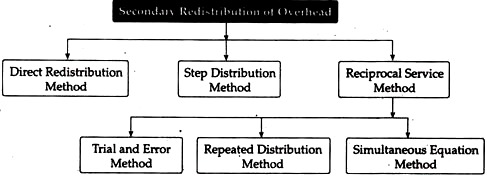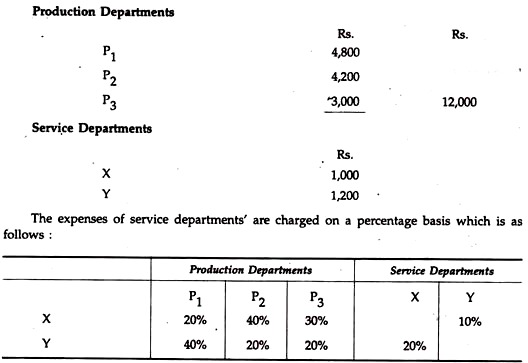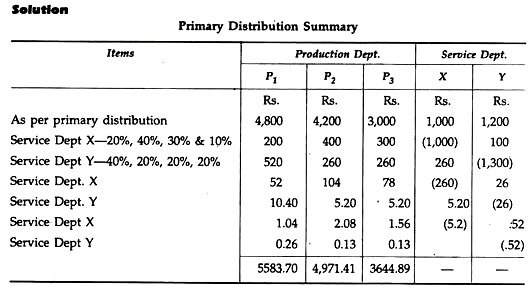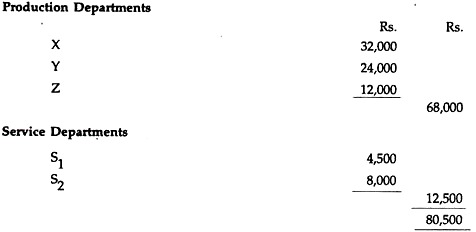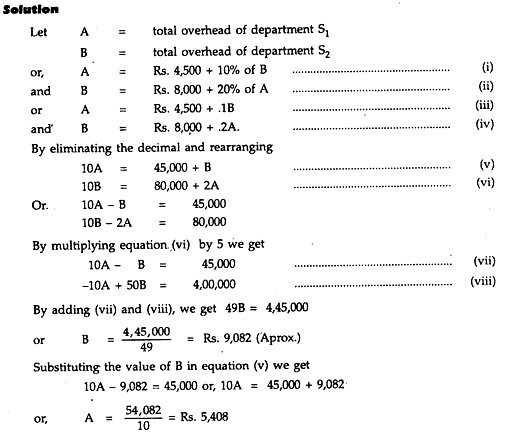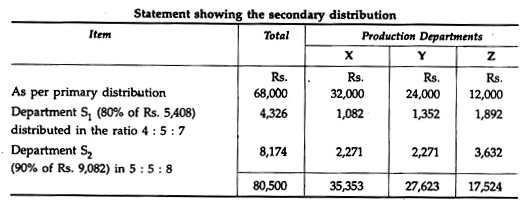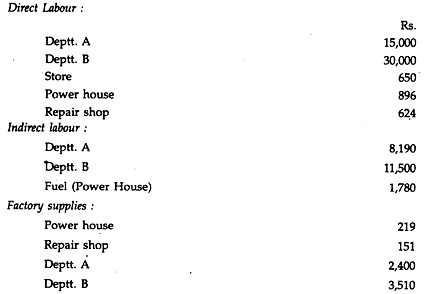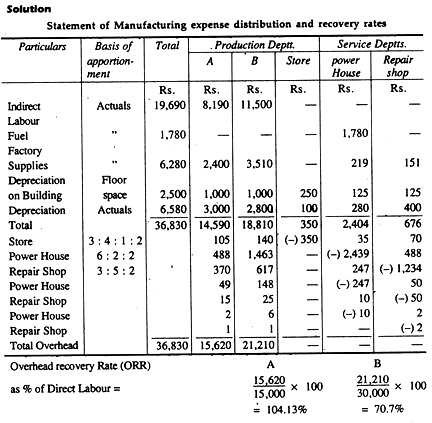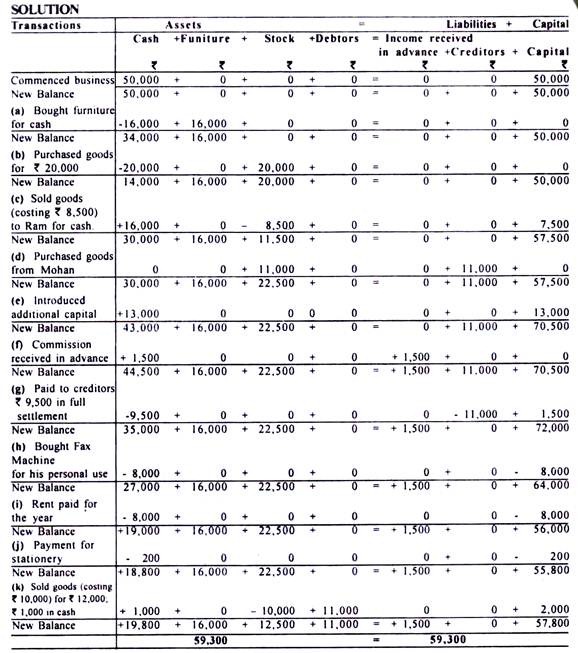The following points highlight the top two methods of apportionment of overheads. The methods are: 1. Primary Distribution of Overhead 2. Secondary Distribution.
Apportionment of Overhead: Method # 1.
Primary Distribution of Overhead:
Primary distribution involves apportionment or allocation of overhead to all departments in a factory on logical and rational basis. This process of apportionment is also known as departmentalisation of overhead. It is to be carefully noted that at the time of making primary distribution, the distinction between production and service departments is ignored.
Following points should be considered for primary distribution of items of overheads:
ADVERTISEMENTS:
(i) Basis for distribution should be equitable and practicable;
(ii) Method adopted for distribution should not be time-consuming;
(iii) Overhead expenses should be distributed among different departments on the basis of benefits received by departments;
For the purpose of primary distribution, a departmental distribution summary is prepared in the following way:
ADVERTISEMENTS:
Basis of Apportionment of Factory Overhead:
Expenses:
1. Lighting, heating, rent, rates and taxes, depreciation on building, repair cost of building, caretaking etc.
2. Insurance on Plant and Machinery, Building; Depreciation on Plant and Machinery; Maintenance of Plant and Machinery.
ADVERTISEMENTS:
3. Insurance on tools and fixtures, power, repairs and maintenance cost etc.
4. Canteen subsidy or expenses, pension, medical expenses, personnel department expenses, cost of recreational facilities. Expenses of wage department
5. Cost of supervision.
Base:
ADVERTISEMENTS:
1. Floor area occupied by each department. Light points for lighting.
2. Capital values of Assets.
3. Direct Labour hours or Machinery hours.
4. Number of employees or workers.
ADVERTISEMENTS:
5. Time devoted.
Apportionment of Overhead: Method # 2.
Secondary Distribution:
In a factory a product does not pass through Service department (S), but service department renders service to production departments for carrying on production function. It is, therefore, logical that the product cost should bear the equitable share of cost of service department. Under this backdrop, the second step is to distribute the total cost of service departments among the production departments.
The process of redistributing the cost of service departments among production departments is known as secondary distribution. Here, the cost of service department means the apportioned overheads plus direct materials plus direct labour and direct expenses of concerned service department.
ADVERTISEMENTS:
Bases for Secondary Distribution:
Service Department Costs:
(i) Employment department
(ii) Maintenance department
ADVERTISEMENTS:
(iii) Purchase department
(iv) Store keeping
(v) Canteen, welfare and recreation
Basis of Redistribution:
(i) Rate of labour-turnover or number of employees.
(ii) Hours worked for each department.
ADVERTISEMENTS:
(iii) No. of purchase orders or value of materials purchased.
(iv) No. of requisitions.
(v) No. of employees of each department.
(i) Direct Redistribution Method:
Under this method, service department’s costs are apportioned to production departments only ignoring service rendered by one service department to another. When this method is followed, the number of secondary distribution will be equal to number of secondary department.
(ii) Step Method:
This method of redistribution gives cognizance to the service rendered by one service department to another service department. The cost of service department which renders service to the largest number of other departments is distributed first.
After this is done, the cost of service department serving the next largest number of department is apportioned. This process continues till the cost of last service department is apportioned. The cost of last service department is apportioned among production departments only.
(iii) Reciprocal Distribution Method:
There may be two or more service departments in a factory and they may render service to each other. In that situation it is logical to give weight to inter-departmental services while distributing the expenses of service departments.
There are three methods for dealing with the distribution of inter-departmental services:
(A) Trial and Error Method
(B) Repeated Distribution Method
(C) Simultaneous Equation Method.
A. Trial and Error Method:
Under this method, the cost of one service department is apportioned to another service department and the cost of another service department plus the share received from first service department is again apportioned to first service department and this process is continued till the balancing figure is negligible.
Problem 1:
Suppose the cost of service department X is Rs.4,000 and that of Y is 4,800; an analysis reveals that X department renders 20% of its service to Y and Y renders 30% of its service to X.
Under Trial and Error Method distribution will be made in the following way.
B. Repeated Distribution System:
Under this method, costs of one service department are apportioned to other service departments and production departments on agreed percentages and this process is repeated till the figures of service departments are too small to be reckoned for further apportionment.
The following steps are involved in this method:
(i) Apply the given percentages to distribute the primary total of first service department. After proper distribution the account of first service department will be closed.
(ii) Apply the given percentages to the second service department whose total is made up of primary charges plus amount apportioned from Service Department 1. This will close the amount of second service department.
(iii) Repeat this process.
(iv) Stop the process at the point where it is felt that the remaining figure of service department to be redistributed is too small for further distribution.
Problem 2:
Swill Co. Ltd. has three production departments and two service departments. From the following information show the distribution of service departments cost under the repeated distribution method:
C. Simultaneous Equation Method:
Under this method, the true costs of service department are ascertained first with the help of simultaneous equations. After that the total costs are distributed among production departments on the basis of given percentages. The following problem will exemplify the method.
Problem 3:
A manufacturing company has three production departments and two service departments.
The primary distribution summary of March 1999 gives the following information:
The service departments’ expenses are charged on a percentage basis which is as follows:
Problem 4:
A manufacturing company has two producing departments, Department A and Department B, and three service departments—Stores, Power house and Repair shop.
From the following information prepare a manufacturing expense budget and calculate overhead recovery rates for the two production departments as percentages of direct labour :
Depreciation calculated as a% of original cost:
Problem 5:
You are supplied with the following information and required to work out the production hour rate of recovery of overhead for departments A, B and C:
